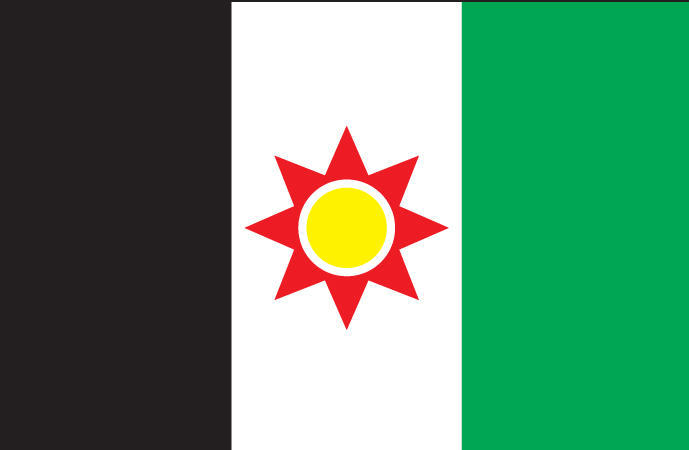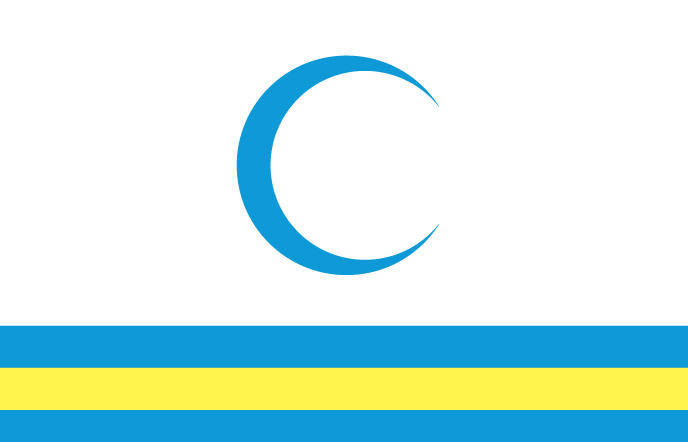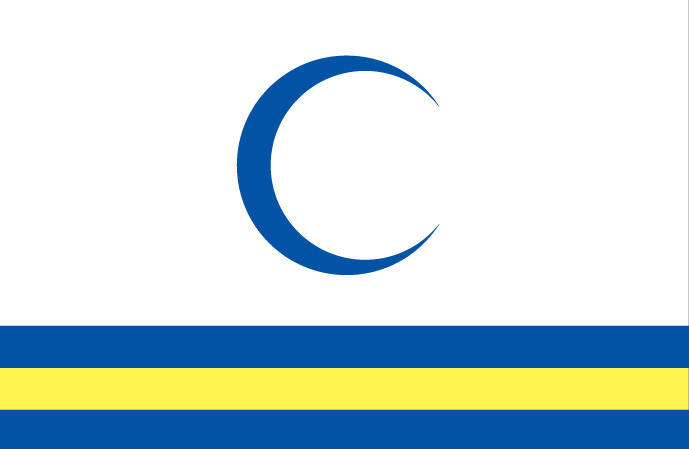


In preparation for the US authorities’ transfer of power to the new interim Iraqi government, the Iraqi Governing Council (IGC) launched an artistic competition to design a new flag for the nation. The winning design, adopted by the IGC in April 2004, was submitted by the Iraqi architect Rif ’at al-Chadirji. Rather than command respect, as national symbols are designed to, the new flag evoked violent reactions and heated debate. Faced with widespread dissatisfaction, the IGC, citing the flag’s “transitional” status, put off the flag’s official sanctioning to the national assembly, which wil be elected in 2005. The transfer of power and the rule of the new interim government was thus oddly carried out under the flag of Saddam Hussein’s fallen Baathist regime.
ON FLAGS IN GENERAL
Far from being mere emblems of national identity, perhaps the most striking aspect of these bits of colored cloth is the manner in which they act as substitutes and fetishes for the nation itself. People divert or transfer an infinite number of meanings, virtues, and feelings of respect, loyalty, devotion, pride and honor to them. Flags play a critical role both in constructing and propagating national identity. They constitute a formidable means of national mobilization. Seeing flags amid the backdrop of an electronic age, it is strange how much they evoke computer chips, strange how many codes and messages can be inscribed on their surface. Graphically, a flag can be said to perform at least three major functions: represent and laud national characteristics; symbolically affirm the nation’s unity; and record major changes in a nation’s history.
THE STORY
The decision to adopt a new flag for Iraq was not made without divisions within the IGC. The Kurdish representatives had suggested reverting to the flag of the 1958 republican revolution. When that option was flatly rejected, they submitted ten variations inspired by that same flag. All were equally rejected because they did not include any references to Islam.
The manner in which Rif ’at al-Chadirji’s design was adopted remains unclear. One version holds that he had initially submitted his design to the competition and simply won, while another claims he was commissioned via telephone by his brother Nasseer Chadirji, a member of the IGC, when that body failed to decide upon a new flag. According to this version, Rif ’at’s design was adopted by a majority vote at the very last minute.
Most immediate reactions to the proposed flag were negative, and many were outright hostile. The dominant impression was that the flag strikingly evoked the flag of Israel. In self-defense, the IGC declared that it had asked the designer to deepen the blue lines before deciding to drop the flag altogether (see flag 1: new Iraqi flag, version 1; see flag 2: new Iraqi flag, version 2). Another version of the story maintains that the blue was initially indigo, but that newspapers had mistakenly printed it in a lighter blue.
The designer himself claimed ignorance, arguing that he had no political preconceptions: “I did not think about Israel. Political opinions don’t concern me. I approached the design from a graphic point of view,” he told The Times. The Israeli connection and Mr Chadirji’s denial aside, it is quite obvious that Mr Chadirji’s “political unconscious” had been quite active for him to conceive of a flag that bears no resemblance whatsoever to any of his country’s previous flags, and that is quite pregnant with political messages.
A “NON-ARAB” FLAG
Perhaps the first striking aspect of the flag is how little relation its colors bear to the geographic colors of the country. Apart from the blue of the two rivers, which also easily evokes the sea, the two most immediate and arguably obvious colors linked to Iraq — a country marked by deserts (sand yellow) and northern fertile mountains in Kurdistan (green) — are abandoned in favor of white, which as many interpreters have maintained, apparently represents peace. Yellow, too, may serve as a symbolic color, as it is linked to the Kurdish people. (It is also the predominant color of Salah ed-Din’s flag.) The blue crescent is a double anomaly in shape and color. Whereas the traditional way of representing the crescent of Islam was as a segment of a full circle, the crescent of the proposed Iraqi flag does not form this shape. As for its color, we have known white crescents (Pakistan), red crescents (Tunisia and Algeria), and yellow crescents (Mauritania). Very few blue crescents exist on flags, save for the flag of the Turkoman ethnicity in Iraq.
The symbolism of the new flag is both ethnic and religious, and herein lies the manipulation of the new Iraqi flag as a national symbol. Ethnicity is recognized for the Kurds, but not the Arabs — the latter are only defined by their religious identities as Muslims. In a way, the logic of the new flag resembles that of the no-fly zones of 1991, through which Iraq was effectively divided into ethnic zones: the northern Kurdish region, the predominately Sunni zone of the middle, and the predominately Shia zone of the south. Thus, despite the fact that the Kurds are Muslims and could have been represented by the crescent, they are represented on the flag as an ethnic-national community by their national color, whereas the nonKurds, that is, the Arab majority, are deprived of the claim of constituting an ethnic-national group and are exclusively defined by their religious-sectarian identity. Paradoxically, most commentators, when referring to flag colors representing the Arabs, speak of Arab nationalism, whereas their reference to flag colors representing Kurds does not include this nationalist qualification. The amalgam is complete: Arab-Arab Nationalist-Saddam Hussein’s Baathist regime.
Importantly, there are no symbolic references on the flag to the Christians of Iraq, who constitute 3 percent of the population; they cannot find a home amid the Muslim symbolism, nor are they represented as Arabs or as Assyrians, as some claim to be ethnically. Also omitted as an ethnic-national community are the Turkmen of Iraq.
The logic of purging the flag of any reference to Arab identity strongly resembles the tendencies of Saddam Hussein’s Baathist regime. In order to reject Kurdish rights, Kurds were symbolically banned from the main symbol of the country’s identity, its flag. That semiological omission is the symbolic equivalent of the Halabja massacre or the Anfal campaign. All of this was done in the name of an organic, exclusivist and totalitarian form of Arab nationalism. To rectify this, in the post-Baathist regime, the logic was reversed: An amalgam of Arab identity and Arab nationalism was created, and the flag purged of any reference to Iraq’s Arab identity or even to the fact that the country harbors at least an Arab ethnicity-cum-nationality among its population, not to mention the fact that that ethnicity-nationality constitutes the majority of the population. In that sense, the new flag becomes the artistic embodiment of a “non-Arab Iraq,” raised by some members of the ex-Iraqi opposition in exile — notably the Iraqi intellectual Kanan Makiya, and Ahmad al-Chalaby, previously an IGC member. Makiya had a vision of a non-Arab Iraq to be constructed after the overthrow of Saddam Hussein’s Baathist regime. The same could be said of the relationship of post-Baathist Iraq to its pre-Arab past. Now that that pre-Arab civilization is accorded its proper historical and cultural status in Iraq, one wonders why that legitimate rectification necessitated the negation of its Arab civilization.
Finally, the different transformations of the Iraqi flag from its creation in 1920 to the present can be read not only as ways to grapple with the problematic question of the country’s identity, but also as a record of the country and its political system moving slowly away from a relatively secular-based political system. Saddam Hussein’s regime played the role of an intermediary phase in the transformation from the secular to the religious, with the post-Saddam regime moving in the direction of a religiously-inspired political system. Is that transition irreversible, and with what consequences —especially as the Kurdish representatives are opposed to the official and integral application of the Shari’ah? The answers to those questions will emerge in the coming months as the newly elected parliament drafts a new constitution and, once again, faces the task of designing a new flag for a new Iraq.